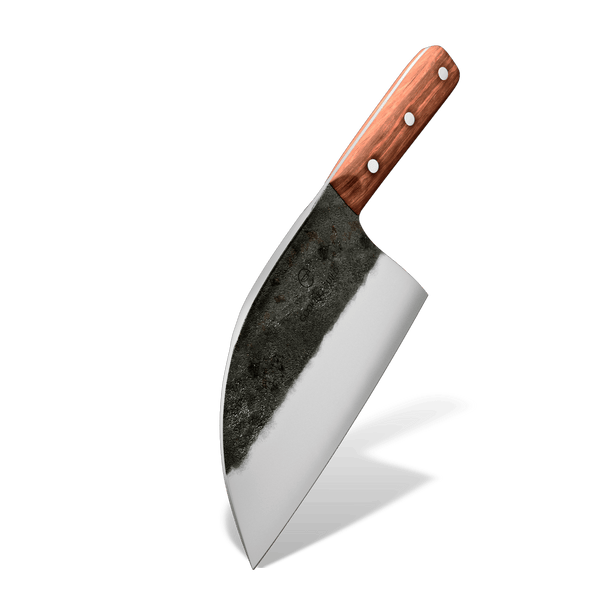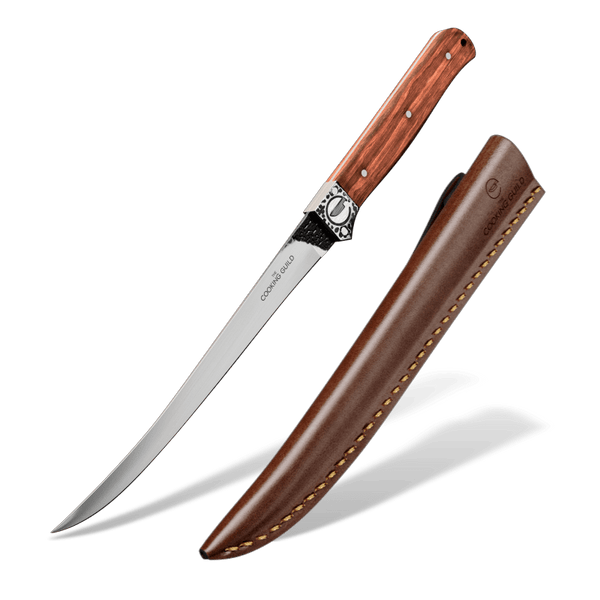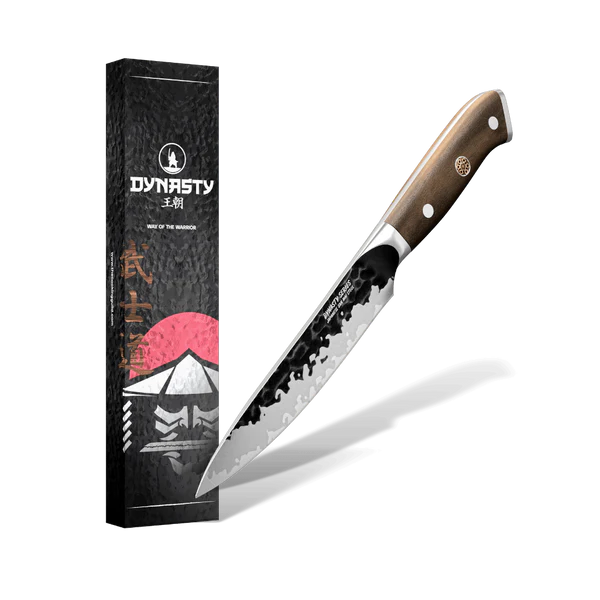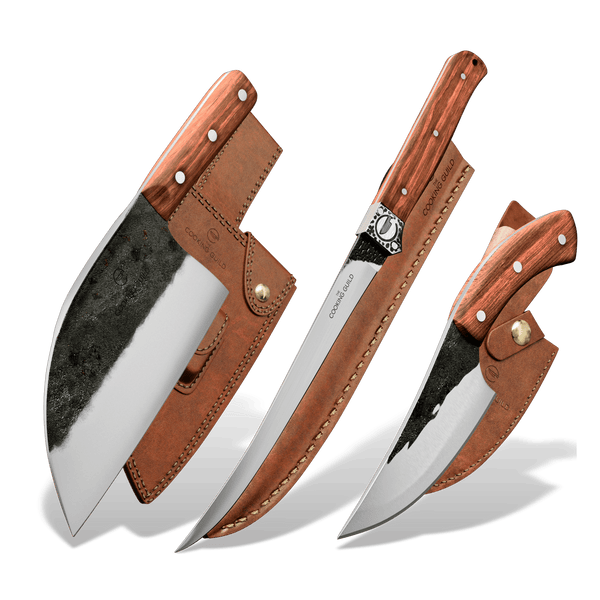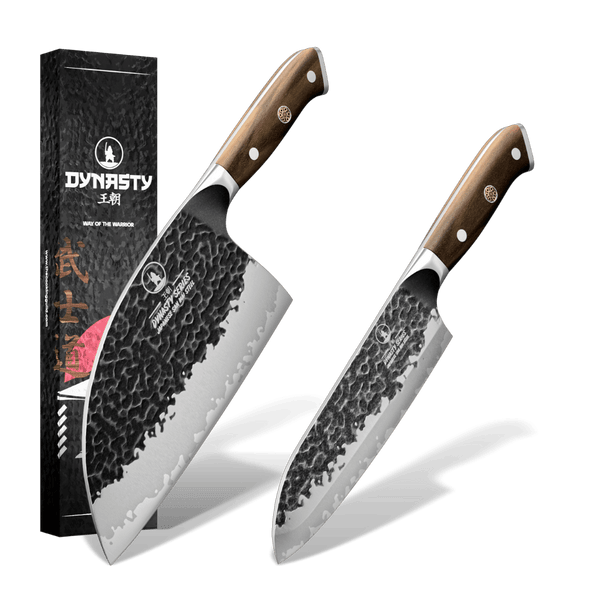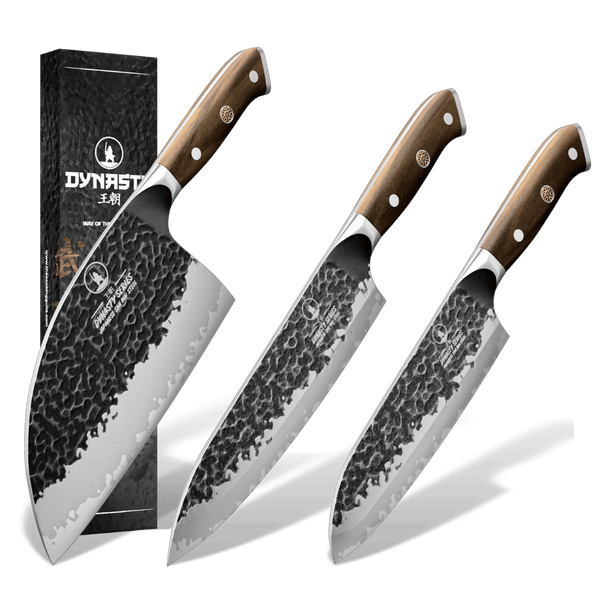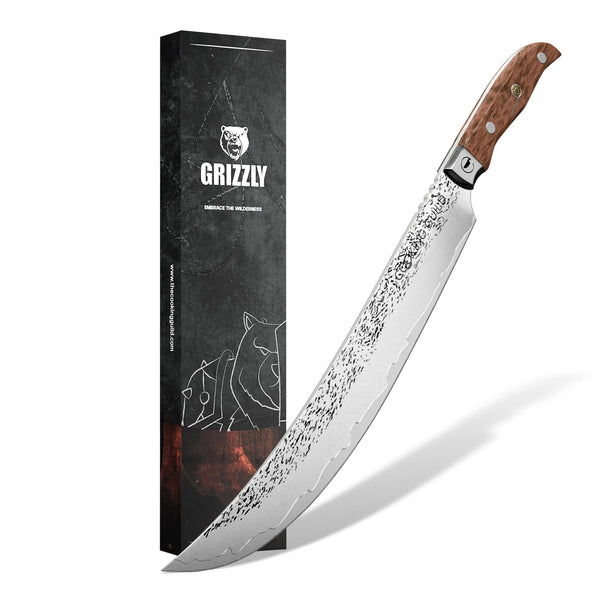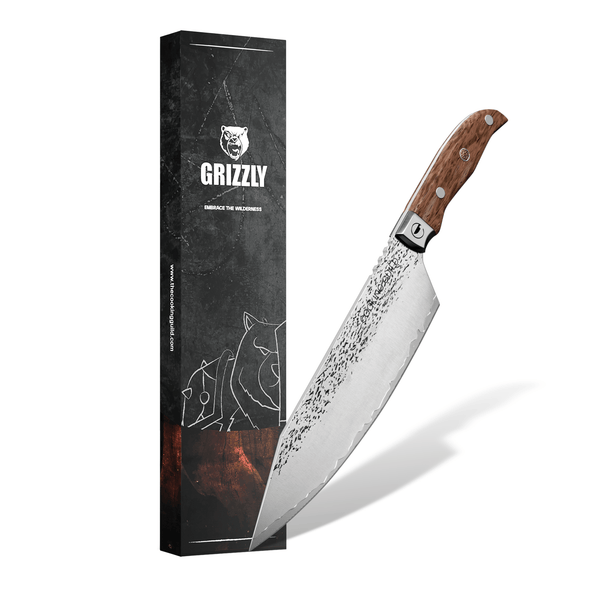When it comes to high-quality kitchen knives and other bladed tools, one term often heard is 'Damascus steel'. Known for its distinctive patterns and durability, Damascus steel holds a coveted place in the world of metallurgy. But what is Damascus steel exactly? Let's delve into its history, characteristics, and why it's so highly prized.
An Overview Of Damascus And Wootz Steel For Beginners
Damascus and Wootz steel are two legendary types of steel with fascinating histories, renowned for their exceptional strength and distinctive surface patterns. Damascus steel, characterized by its wavy designs, was historically used for crafting swords and other weapons. Its origins lie in the Middle East, where blacksmiths employed unique forging techniques to create this prized material. On the other hand, Wootz steel, also known as crucible steel, boasts a granular appearance and dates back to ancient times. This type of steel was highly valued for its remarkable strength and sharpness. As we delve into their individual characteristics, let's explore the captivating tales behind Damascus and Wootz steel for those who are new to these intriguing materials.
Key Takeaways: Damascus Steel
- Distinctive Surface Patterns: The steel is recognized for its unique wavy patterns on the surface of the blade, which are a result of the carbide layering and forging process.
- Historical Significance: It has a rich historical background and was used in the Middle East for crafting high-quality swords and other bladed weapons.
- Lost Technique: The original manufacturing technique for authentic steel has been lost to history, but modern artisans use pattern-welding methods to recreate similar patterns.
- Strength and Sharpness: It was prized for its exceptional strength, sharpness, and durability, making it a sought-after material for weapons.
- Cultural and Artistic Value: The distinct appearance of the steel makes it highly valued not only for its functional properties but also as a work of art.
- Modern Reproduction: While the true secret of traditional steel remains a mystery, contemporary blacksmiths continue to produce pattern-welded blades inspired by its legacy.

The History of Damascus Steel
The story of steel dates back to as early as 300 B.C., with its name derived from the capital city of Syria, Damascus. This ancient city was a bustling hub for trade in the Middle Ages, and weapons made from steel were renowned for their superior sharpness, flexibility, and unique water-like patterns.
The original method for creating steel, also known as Wootz steel, has unfortunately been lost to time. Today, modern metallurgists and blacksmiths have developed methods to create a type of steel that closely mimics the properties and appearance of the original.
What Is Wootz Damascus
Wootz Damascus, also known as "true Damascus," is a captivating fusion of two legendary steel types - Wootz steel and Damascus steel. This remarkable combination incorporates the exceptional strength and sharpness of Wootz steel with the distinctive wavy patterns of traditional steel. Crafted through a meticulous process, Wootz Damascus blades showcase the best of both materials, resulting in a highly prized and visually stunning blade with a rich historical heritage. Today, modern blacksmiths and artisans continue to explore and revive this unique art, perpetuating the legacy of Wootz Damascus as a testament to ancient metallurgical craftsmanship.
How Did Wootz Steel Become Damascus Steel
The association with this comes from historical trade and interaction between different regions. During the medieval period, Wootz steel from India was exported to the Middle East, particularly to the city of Damascus, which was a significant trading hub. The Middle Eastern blacksmiths, intrigued by the quality and properties of Wootz steel, sought to create similar blades using their traditional pattern-welding techniques.
The term "Damascus steel" was likely attributed to these Middle Eastern bladesmiths' creations because they were being produced in Damascus, and the distinctive wavy patterns resembled those found in traditional steel. However, it's important to note that the original Wootz steel and the pattern-welded steel produced in the Middle East were not the same, even though they were often referred to as Damascus steel.
Crucible Steel From Other Places, Maybe
According to Ann Feurbach, crucible steels might not have been exclusively produced by southern Indians during that time. There is evidence suggesting that some ingots imported to Syria could have originated from regions in Central Asia, such as Persia, western China, and Russia. These regions utilized a different crucible process known as "fulad," where high carbon steel and low carbon steel were melted together in a crucible. Although fulad steel hasn't received as much attention as other types, it adds to the historical context as it indicates a more widespread use of such steel-making techniques. However, the full integration of Ann Feurbach's work into the discussion is not attempted here, and its impact on understanding steel is not explored in this context. Nevertheless, it is valuable to acknowledge the broader distribution of this crucible steel manufacturing process during that era.
Modern Wootz Steel Is Kind Of A Thing
In the documentary "The Secrets of Wootz Damascus Steel" by Mike Loades, Al Pendray and John Verhoeven work to develop a consistent method for forging crucible steel with the swirling grain formation seen in Wootz Damascus Steel. Their efforts have dispelled the belief that the secret to making true Damascus steel is lost. Although achieving a consistent pattern remains a challenge, individuals like Rick Furrer and Niels Provos have made attempts to reproduce Wootz steel with varying degrees of success. Mass production of Wootz steel remains uncertain, as the process remains in the hands of historians, metallurgists, and skilled blacksmiths.

The Reinvention Of Damascus Steel
The reinvention of this steel has been an awesome journey that mixes ancient craftsmanship with modern metallurgical tricks. Back in the day, the original way to make this legendary steel was lost, leaving only tales of its super strength and funky wavy patterns.
But guess what? Passionate blacksmiths and metallurgists didn't give up! They decided to bring back the magic. Nowadays, they use pattern-welding methods, stacking and forging different steel types together to get those cool wavy patterns. It's like bringing history back to life!
With the help of modern metallurgy, they've come up with new Damascus-style steels that have the same strength, sharpness, and visual appeal. It's a total win-win for collectors and folks who love top-notch blades.
From knife enthusiasts to history buffs, people can't get enough of it. While they might not have the exact original recipe, the modern twist on Damascus steel ensures its legacy lives on, celebrating the past while embracing the awesomeness of the present!
Where Damascus Steel Gets Its Name
The name "Damascus steel" is derived from the city of Damascus, which was a renowned trading center in the Middle East during medieval times. The steel's association with Damascus is due to historical trade routes and the fame of its skilled blacksmiths.
Back then, swords made from this exceptional steel were highly sought after for their superior quality, sharpness, and durability. As these swords were traded and passed along various routes, they became known as "Damascus swords" or "swords from Damascus," linking the steel to the city.
Cast Damascus Steel
Cast Damascus steel is created by melting different steel alloys and pouring them into a mold, resulting in striking patterns. While it may lack the structural integrity of traditional pattern-welded Damascus steel, it offers a more accessible way to achieve its visual appeal. Modern technology has made it popular for knife blades, jewelry, and decorative items.
The History Of Pattern Welded Damascus Steel
Pattern-welded Damascus steel, also known simply as Damascus steel, has a rich and ancient history dating back to the Middle East during medieval times. The original techniques used to produce this legendary steel have been lost to history, adding to its mystique.
The process of pattern-welding involves layering and forge-welding different types of steel with varying carbon content. These layers are then repeatedly folded and hammered, creating a homogenous and exceptionally strong blade. As a result, the steel exhibits the distinctive wavy patterns on its surface.
Pattern Welded Steel As The Wootz Alternative
Pattern-welded steel has been considered as an alternative to Wootz steel due to its similar appearance and intriguing patterns. While Wootz steel originated in ancient India and had a distinctive microstructure with cementite bands, pattern-welded steel, including Damascus steel, gained prominence in the Middle East and Europe for its unique surface patterns achieved through layering and forge-welding different types of steel.
The decline of traditional Wootz steel production led to the rise of pattern-welding as a viable alternative, as blacksmiths sought to recreate blades with comparable visual appeal and functional properties. Pattern-welded steel allowed artisans to achieve beautiful and intricate patterns on the surface, making the blades highly valued as works of art and functional weapons.
The renaissance of pattern-welded steel has been fueled by the fascination with ancient craftsmanship and the desire to revive the allure of historical blades. Today, bladesmiths continue to explore and experiment with pattern-welding techniques, offering enthusiasts a glimpse into the ingenuity of the past while embracing modern craftsmanship to create stunning and unique blades.
Pattern Welded Damascus Restarted With Guns Then Moved To Knives
Pattern-welded Damascus steel experienced a revival starting with guns and later transitioned to knives. During the 1970s and 1980s, interest in traditional craftsmanship led to a resurgence in the art of pattern-welding. Gunsmiths and collectors began experimenting with pattern-welded Damascus steel to create distinctive gun barrels, firearm components, and knife blades.
The techniques used to make these pattern-welded gun barrels and firearm parts were eventually adapted and refined for crafting knives. Bladesmiths recognized the visual appeal and strength of pattern-welded Damascus steel, making it a sought-after material for high-end custom knives.
Which Damascus Steel Is The “Real” One
If you're new to the world of Damascus steel, here's the deal: the term "Damascus steel" can actually refer to two different types of steel.
First, we've got modern Damascus steel, which is a pattern-welded steel. It's made by forge welding and twisting together two or more different steels, creating those cool and distinctive patterns on the blade. To bring out the pattern clearly, the metal needs to be dipped in acid (a process called "etching").
Then, there's the crucible steel, known as Wootz Damascus, which comes from a single ingot forged in south India. After being forged and thermal cycled, it develops a surface "water" pattern. Like modern Damascus steel, Wootz Damascus also requires acid etching to reveal the pattern.
Some historians may argue that crucible Wootz steel is the "real" Damascus because it started the craze and got everyone into making water-patterned blades. But in reality, if you ask a knife maker today for a Damascus steel knife, they're more likely to make you a pattern-welded steel blade.

Unique Characteristics of Damascus Steel
Distinguished by its beguiling patterns and renowned for its unparalleled strength, Damascus steel stands as a testament to the ingenuity of ancient metallurgists. In the world of blades and weaponry, it holds a position of unmatched prestige, captivating enthusiasts with its remarkable properties and distinctive allure. The unique characteristics of Damascus steel, forged through a fusion of meticulous craftsmanship and scientific prowess, have bestowed upon it an aura of mystery and reverence that endures to this day.
Distinctive Patterns
One of the most striking characteristics of Damascus steel is its beautiful and unique patterns. These patterns are a result of the different types of steel used and the process of folding and forging them together. Each piece of Damascus steel is unique, with patterns ranging from waves and spirals to loops and stripes.
The Source Of The Water Pattern
The mesmerizing "water" pattern found in Damascus steel is a result of a fascinating metallurgical process. This pattern originates from the unique microstructure of the steel, which includes the presence of cementite bands distributed within a softer matrix. During the forging and thermal cycling of the single ingot from south India, these distinct microstructural features interact, creating the beautiful "water" pattern on the surface of the blade. When the steel is etched with acid, the pattern becomes even more pronounced, showcasing the mesmerizing beauty.
Pattern-welded And San-mai Damascus Steel
Pattern-welded Damascus steel and San-mai Damascus steel are two captivating variations of this legendary material. Pattern-welded Damascus steel is crafted by forge-welding layers of different steel types, producing intricate surface patterns. On the other hand, San-mai Damascus steel features a core of high-carbon steel sandwiched between layers of lower-carbon steel, offering a combination of strength and flexibility. Both techniques result in visually stunning and durable blades, cherished by knife enthusiasts and collectors alike for their artistic appeal and functional superiority.
Durability and Edge Retention
Damascus steel is highly prized for its durability. The forging process aligns the grain structure of the steel, resulting in an incredibly tough and resilient material. Moreover, Damascus steel blades are known for their excellent edge retention, staying sharp for longer periods compared to regular steel blades.
Flexibility
Despite its hardness and durability, Damascus steel also offers a certain degree of flexibility. This balance between hardness and flexibility makes Damascus steel ideal for making knives and other bladed tools.
What Is The Difference Between Steel And Damascus Steel?
The main difference between regular steel and Damascus steel lies in their manufacturing processes and resulting properties.
Steel:
- Regular steel is a common alloy made primarily from iron and carbon, with small amounts of other elements such as manganese, chromium, and nickel.
- It is a homogeneous material with consistent composition throughout the entire piece.
- The properties of regular steel, such as hardness, toughness, and sharpness, depend on its carbon content and the specific alloying elements used.
Damascus Steel:
- Damascus steel is a type of steel known for its distinctive wavy patterns on the surface, created through a unique forging technique.
- It is made by forge-welding layers of different types of steel together, resulting in the characteristic patterns.
- The layered structure of Damascus steel gives it unique properties, such as exceptional strength, sharpness, and durability.
- While traditional Damascus steel's original manufacturing process has been lost to history, modern blacksmiths use pattern-welding methods to recreate similar patterns.
Types Of Steel Used To Make Damascus Knives
There are various types of steel used to make Damascus knives, each offering unique properties and contributing to the blade's overall performance. Some common types include:
- High Carbon Steel: High carbon steel provides excellent hardness and edge retention, making it a popular choice for the core or cutting edge of the Damascus blade.
- Low Carbon Steel: Low carbon steel offers greater toughness and flexibility, making it suitable for the outer layers of the blade, enhancing its durability.
- Nickel Steel: Nickel steel is often used as one of the layers in Damascus steel to create contrast and enhance the visual appeal of the blade.
- Tool Steel: Tool steel adds wear resistance and toughness to the blade, making it suitable for demanding tasks.
- Stainless Steel: Some modern Damascus knives incorporate stainless steel layers to reduce maintenance and prevent corrosion.
- Damasteel: Damasteel is a modern composite material made from powder metallurgy, combining various stainless steel alloys to create a visually stunning and high-performance Damascus-like pattern.
The combination of different steel types through pattern-welding or layering gives Damascus knives their signature appearance and a blend of desirable properties, making them highly sought after by knife enthusiasts and collectors.

The Making of Damascus Steel
Modern Damascus steel is made by forging together multiple layers of different types of steel, which are then folded and manipulated to create patterns reminiscent of flowing water or waving grain. The process involves repeatedly heating, hammering and folding the steel, which contributes to its strength and creates the distinctive layered patterns.
Choosing Steel For A Damascus Blade
When choosing steel for a Damascus blade, it is crucial to consider the desired characteristics and performance of the final blade. Damascus steel is renowned for its exquisite patterns and exceptional durability. Generally, a combination of high-carbon steel and low-carbon steel layers is used to create the distinctive pattern. The high-carbon steel contributes to edge retention and sharpness, while the low-carbon steel enhances flexibility and toughness. Choosing high-quality, well-balanced steel with excellent heat-treating properties will ensure a Damascus blade that exhibits both stunning aesthetics and superior cutting performance.
The Nuts And Bolts Of Damascus Steel
Crafting modern Damascus steel remains an intricate art form that involves a series of meticulous steps. Beginning with the selection of the appropriate steel with specific alloys and carbon content, the process entails working with varying temperatures during forging, shaping, and quenching the steel.
Each element within the steel serves a distinct purpose. Carbon enhances hardness, edge retention, tensile strength, and resistance to wear and abrasion, while manganese improves grain structure, hardenability, strength, and wear resistance. Chromium, a crucial element in stainless steel (requiring at least 13% chromium for stainless properties), enhances hardness, tensile strength, and resistance to wear and corrosion.
To create the Damascus pattern, the two steels are stacked in alternating layers, forming billets that undergo twisting, folding, heating, and hammering. Once the billets have undergone numerous folding and hammering cycles and reach the appropriate dark red shade (light red indicating a high temperature prone to cracking), the steel is quenched to achieve hardness.
In the final stages, the skilled craftsman hammers, lengthens, and flattens the metal, revealing a distinct and unique Damascus pattern. This laborious process yields exceptionally sharp and stunningly beautiful Damascus steel knives that exemplify the artistry and precision involved in their creation.
Why Is Damascus Steel So Expensive?
Damascus steel commands a high price tag primarily because of the intricate and labor-intensive production process. Skilled craftsmen spend significant time and effort forging, layering, twisting, and folding different types of steel to create the distinctive patterns. This artisanal approach, coupled with the use of premium materials like high-quality steel with specific alloys, adds to the overall cost.
Additionally, the rarity and historical significance of Damascus steel contribute to its premium value. As a sought-after material with unique aesthetics, collectors and enthusiasts are willing to pay more for a piece of this ancient and captivating tradition. With limited production, increased demand, and a level of exclusivity, the allure of Damascus steel continues to make it a symbol of exquisite craftsmanship and enduring beauty.
How Strong Is Damascus Steel Compared To Other Popular Steels?
Damascus steel is like the superstar of knife materials when it comes to strength. It totally outshines regular carbon steel with its high-carbon layers, bringing on insane hardness and edge retention. You can count on it to slice through stuff like a boss and stay sharp for a long time.
Not to mention, it's no slouch compared to those stainless steel blades either. While stainless steel loves to flex its corrosion-resistant muscles, Damascus steel still manages to pack a punch in the cutting department with its killer combo of high-carbon power.
Just remember, not all Damascus steel is cut from the same cloth. The way it's made and the skills of the bladesmith can make a big difference in its strength and performance. But when you've got the real deal, you've got a cutting companion that's a force to be reckoned with – both tough and stylish all at once!
Do I Need To Sharpen Damascus Steel Differently Than Other Types Of Steel?
When it comes to sharpening Damascus steel, the process is not fundamentally different from sharpening other types of steel. However, there are some considerations to keep in mind to ensure you maintain the beauty and integrity of the Damascus pattern.
- Sharpening Angle: Damascus steel knives, like most high-quality knives, typically have a fine edge. To maintain the edge geometry and sharpness, it's essential to sharpen at the same angle that the blade was originally ground. Use a sharpening tool or whetstone with a consistent angle guide for best results.
- Sharpening Grit: Begin with a coarse grit stone or sharpening tool to remove any dullness or nicks from the blade. Then, progress to finer grits for a polished and sharp edge. Damascus steel is often hard, so a higher grit stone (e.g., 1000 or above) is recommended for the finishing touch.
- Water or Oil: Some whetstones require water for lubrication, while others use oil. Check the instructions for your specific sharpening stone. Water stones are usually more common and work well for sharpening Damascus steel.
- Avoid Power Tools: While power sharpening tools can be effective for certain steels, they might be too aggressive for Damascus steel. The intricate patterns can be easily damaged by aggressive power grinding, so it's best to stick with manual sharpening methods.
- Consistent Strokes: Maintain a steady and consistent stroke while sharpening, ensuring even contact with the edge along the entire length of the blade. Avoid excessive pressure, as Damascus steel is already hard, and too much force might lead to chipping.
- Honing: Regular honing using a honing rod or steel can help maintain the edge between sharpening sessions. Honing realigns the edge and keeps it sharp for longer.
- Careful Cleaning: After sharpening, be sure to clean the blade thoroughly to remove any metal particles or residue. A soft cloth or paper towel should suffice for cleaning.

How Can You Tell Real Damascus Steel From Fakes?
Distinguishing real Damascus steel from fakes can be challenging, especially with modern reproductions and imitations on the market. Here are some key factors to help you identify genuine Damascus steel:
Wavy Patterns: Traditional Damascus steel is renowned for its wavy or flowing patterns caused by the layering and forging process. Look for a distinctive pattern with visible variations in the steel layers. Fakes may attempt to replicate this pattern, but authentic Damascus often exhibits a unique and intricate design.
Acid Etching: Acid etching is a common technique used to bring out the pattern in Damascus steel. Genuine Damascus will show a well-defined and prominent pattern after acid etching. Be cautious of blades that claim to be Damascus but lack a visible pattern even after etching.
High-Quality Materials: Damascus steel is typically made from high-quality, layered steel with varying carbon content. Authentic Damascus should consist of different steel types, usually high-carbon and low-carbon, forged together to create the pattern. If the blade is made from a single type of steel or low-quality materials, it might not be genuine.
Price and Source: Genuine Damascus steel is labor-intensive to produce, so it often commands a higher price than regular steel. If a blade labeled as Damascus is unusually cheap, it may be a sign of a fake or low-quality imitation. Purchase from reputable sellers or skilled bladesmiths known for producing authentic Damascus steel.
Weld Lines: In authentic Damascus, you may find visible weld lines or slight irregularities where the layers are fused together. These are a result of the forge-welding process and add to the authenticity of the blade.
Magnetic Test: Some modern Damascus blades might be made using stainless steel, which is not magnetic. If a Damascus blade is magnetic, it may indicate that it's made from carbon steels or different steel types.
Wootz Damascus, Pattern Welded Damascus, And Solid Steel: Which Is Better
When it comes to selecting a high-quality blade, enthusiasts often find themselves debating the merits of different steel types. Among the most sought-after choices are Wootz Damascus, Pattern Welded Damascus, and Solid Steel. Each of these materials brings its unique strengths and characteristics to the table, leaving enthusiasts to ponder which one reigns supreme. In this comparison, we'll explore the distinctive attributes of each steel type to shed light on the eternal question: Which is better?
Wootz Damascus Vs. Modern Solid Steel
Experiments in this field are relatively limited, but Verhoven conducted a CATRA test to compare the edge performance of Wootz Damascus blades with 1086 and 52100 tool steels, as well as AEB-L stainless steel. The findings revealed that, at high hardness levels, both 1086 and 52100 exhibited superior cutting ability and edge retention compared to true Damascus. Moreover, the Uddeholm AEB-L stainless steel outperformed all of them overall when tested at high hardness. However, Wootz steel showed a significant improvement in performance at a softer hardness, indicating its strengths may lie in that specific range.
Pattern Weld Damascus Vs. Modern Solid Steel
The Thomas family knifemakers conducted their own CATRA test comparing pattern-welded Damascus steel (AEB-L and 154CM) with solid pieces of each steel type. Surprisingly, the pattern-welded Damascus performed in between, with higher edge retention than AEB-L and lower than 154CM, and balanced initial slicing ability. While this challenges the notion of Wootz steel being universally inferior and pattern-welded steel always underperforming its components, the limited scope of the experiments calls for cautious skepticism regarding manufacturers' claims about Damascus steel's superiority in knife performance. More research is needed for a comprehensive understanding.
Wootz Steel Was Impressive For Its Time
In his report on Wootz Damascus CATRA testing, Verhoeven mentions that the true Damascus steel blades from antiquity were likely superior to the ones used by European Crusaders. The European blades might have been hardened to around 40 HRC due to limited access to pure steel and specific techniques of that time. In contrast, Wootz Damascus steel excelled at around that hardness level.
In the medieval era, obtaining pure steel on a large scale to equip armies was challenging, making the technology of producing Wootz ingots highly valuable. Today, our steel standards far exceed those of the medieval period in any country.
For context, the criteria set by the American Bladesmith Society to become a Master Bladesmith involve forging a pattern-welded knife with 300 layers capable of slicing a one-inch rope in half with one cut, chopping through a 2×4 without chipping, maintaining a sharp enough edge to shave hair, and withstanding being bent 90 degrees without cracking. Such legendary qualities may have quickly spread among Medieval travelers sharing tales of a Syrian sword capable of cutting an iron helm in half.
Does Damascus steel rust?
Yes, Damascus steel can rust if not properly cared for. Damascus steel is typically made from high-carbon steel, which is more susceptible to rust compared to stainless steel. The unique patterns and layering in Damascus steel can create microstructures that might encourage rust formation if exposed to moisture or corrosive elements.

Tips On Taking Care Of Damascus Steel
To prevent rust on Damascus steel, it's essential to follow proper maintenance and care:
- Keep the blade dry: After using the Damascus steel blade, make sure to wipe it dry with a soft cloth or paper towel. Avoid leaving the blade wet or damp for extended periods.
- Clean after use: Clean the blade thoroughly with mild soap and water after each use. Avoid using harsh chemicals or abrasive cleaners that might damage the steel or its finish.
- Apply a protective coating: Some Damascus steel blades come with a protective coating or patina to help resist rust. If your blade has such a coating, follow the manufacturer's instructions for maintaining it.
- Oil the blade: Applying a thin coat of mineral oil or food-grade lubricant to the blade can help protect it from moisture and prevent rust. Be sure to remove excess oil after application.
- Store properly: Store the Damascus steel knife in a cool, dry place and avoid leaving it in damp environments or sheaths for extended periods.
- Regular maintenance: Regularly inspect the blade for any signs of rust or discoloration. If you notice any, remove it immediately using fine steel wool or a rust eraser. Afterwards, clean and dry the blade thoroughly.
Other Stuff You Could Maybe Learn
In our effort to provide reliable information, we have referenced and linked to the best sources available on the internet regarding this topic. However, for a comprehensive understanding, delving into books or hands-on forging experiences is highly recommended.
For a detailed primer on the science behind knife making, we suggest Larrin Thomas' book, "Knife Engineering: Steel, Heat Treating, and Geometry." It not only covers a vast range of knife-making information but also includes an insightful section on Damascus steel.
John Verhoven's book, "Damascus Steel Swords: Solving the Mystery of How to Make them," co-authored with Al Pendray, offers a mix of science and history, intertwining their friendship with their quest to create Wootz steel. Additionally, we have encountered other books on metallurgy authored by Verhoven that are worth exploring, though they may be more expensive.
For insights into pattern welded blades' historical context, "Swords of the Viking Age" by Ian Peirce is considered a standard source on the topic.
Regarding books on forging pattern welded Damascus, we are aware that Jim Hrisoulas is a notable name in historical weapon making. Bladesmiths often reference his works, such as "Damascus Steel: Theory and Practice" and "The Pattern Welded Blade: Artistry in Iron," for those eager to learn the craft.
Damascus Steel in the Kitchen
In the realm of kitchenware, Damascus steel knives are highly sought after. They're not just about aesthetic appeal - these knives offer a level of performance that's hard to match. The sharpness, durability, and edge retention of Damascus steel make it perfect for tasks requiring precision, like slicing delicate fruits or carving meat.
Damascus Steel, with its rich history, unique patterns, and exceptional properties, continues to fascinate and allure. Whether it's for a chef knife, a cleaver knife, a Japanese knife or even hand-forged knives, Damascus steel stands out as a symbol of quality and craftsmanship. The next time you see a knife with distinctive wave patterns on its blade, you'll know the mystique and allure that is Damascus steel.
The King (Or Queen) Of The Kitchen
Thanks to the dedication of bladesmith enthusiasts and Stanford academics, Damascus steel has evolved from the legendary and fearsome blades of Moorish lore into an incredibly versatile material with limitless applications.
As the strength and durability of Damascus steel blades have become evident, an increasing number of professional chefs are turning to Damascus steel kitchen knives as their primary choice. The allure lies in their exceptional sharpness, although sharpening them can be challenging for beginners. To ensure your Damascus steel knives maintain their longevity, entrusting an expert for sharpening is highly recommended.
At The Cooking Guild, you can experience the beauty of Damascus steel kitchen knives firsthand. Our premium kitchen knives are available individually or as part of a series of sets. Additionally, we offer the perfect storage solution with our elegant Heavy Duty Waxed Canvas Leather Knife Roll. For optimal blade care, our knife sheaths are available for all our knives and are designed to keep your knives in top-notch condition.
If you're in pursuit of the finest Damascus steel kitchen knives, look no further than The Cooking Guild!
Our Favorite Damascus Steel Knives
Step into the world of extraordinary cutlery as we present "Our Favorite Damascus Steel Knives" – a curated collection of four exceptional blades, each a masterpiece that marries timeless craftsmanship with the distinctive allure of Damascus steel.
ONYX Special Edition 8" Chef Knife
Presenting the ONYX Special Edition 8" Chef Knife, a knife that perfectly embodies versatility and elegance. Crafted for culinary enthusiasts who value precision and aesthetics alike, this chef knife is not just a kitchen accessory - it's a symbol of superior craftsmanship and meticulous attention to detail.

Superior Blade Quality
With a length of 8 inches (20 cm) and a width of 1.8 inches (4.5 cm), the blade is ideally sized to handle a myriad of tasks, from slicing fruits and vegetables to dicing meat. Its remarkable hardness of HRC61 ensures long-lasting edge retention, allowing for consistent performance even after extensive use.
Exceptional Handle Design
The handle of this chef knife is made from black polished ebony, recognized for its durability and comfort. The detailed mosaic pin adds an element of sophistication, making the knife a striking addition to any kitchen decor. Measuring 4.7 inches (12 cm) in length, the handle provides a comfortable grip for improved control during use.
ONYX Damascus Steel Cleaver
Blade Excellence
With a length of 8 inches (20 cm) and a width of 3.7 inches (9.6 cm), the blade is perfectly sized for a range of tasks, from chopping vegetables to cutting through meat and bones. The impressive hardness of HRC61 ensures the blade retains its sharpness, even after repeated use.
Handle Craftsmanship
The handle of this cleaver is made from black polished ebony, known for its durability and comfort. The detailed mosaic pin adds a touch of elegance, making the knife a beautiful addition to any kitchen. The handle measures 4.7 inches (12 cm) in length, providing a comfortable grip for enhanced control during use.
The full tang design ensures excellent balance, allowing you to chop, slice, and dice with ease and precision. This design also contributes to the knife's robustness, promising a long life even with heavy usage.
ONYX Special Edition Hanta

Unmatched Blade Quality
With a length of 5.5 inches (14 cm) and a width of 2 inches (5 cm), the blade is perfectly suited to handle a variety of tasks, from intricate slicing to detailed carving. Its remarkable hardness of HRC61 ensures prolonged edge retention, allowing for consistent performance even after extensive use.
Superior Handle Design
The handle of this knife is constructed from black polished ebony, recognized for its robustness and comfort. The detailed mosaic pin injects a dash of sophistication, making the knife a stunning addition to any kitchen ensemble. Measuring 4.3 inches (11 cm) in length, the handle provides a comfortable grip for improved control during use.
The full tang design guarantees excellent balance, enabling you to cut, slice, and carve with ease and accuracy. This design also enhances the knife's durability, promising longevity even with regular, heavy-duty usage.
